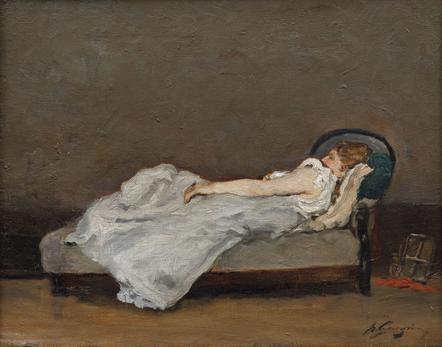Lot #52

Paul Gauguin (1848–1903)
Mette Asleep on a Sofa
Estimate: 15,000,000 CZK - 20,000,000 CZK
Starting price: 12,000,000 CZK
12,400,000 CZK
Paul Gauguin is known to the general public worldwide as one of the most original artists whose work had a formative influence on the development of modern art history. Although he ranks among the most-awarded authors, his oil painting has not yet appeared in domestic auctions. Mette Asleep on a Sofa, one of the first, if not the first, figural compositions Gauguin executed, thus presents a unique opportunity for art collectors. In the mid-1870s, Gauguin was already devoted to painting but still kept his job as a stockbroker, where he remained until the collapse of the Paris stock market in January 1882. Portrait of sleeping Mette is Gauguin’s only surviving work of this kind from the mid-1870s, that is, from the time before he finally decided to become a professional artist. At the same time, this painting anticipates his artistic interest in his own home, furnishing and, above all, family members, who, from 1880, increasingly inspired him to paint, draw and sculpt.
His wife, Mette Sophia Gad, originally from Denmark, whom he married in November 1873, became his model here. Gauguin most likely executed her portrait in their Paris flat on Rue de Chaillot 54, where they moved after the birth of their first son, Emil. A comparison of Gauguin’s other portraits and still lifes created between 1876 and 1877 in which the same background occurs suggests that the resting Mette was portrayed in this apartment, in a room used as a studio – as evidenced by the small canvas in the lower right corner. It is placed on a red drapery, which, together with the cross of the stretcher, is considered by some researchers to be a symbolic reminder of the suffering of Jesus. The artistic approach, the colours, the chosen subject matter, and the rendering still testify to a phase of the search for his own style, during which Gauguin naturally started from the tradition of the Old Masters. The neoclassical portrait of Madame Récamier, also dressed in white and resting on a chaise longue, by Jacques-Louis David, probably served as the most likely inspiration here. However, Gauguin approached the painting of this subject matter in a different and free-spirited manner – he depicted his wife in a negligée, which was rare for 19th-century painting until then.
Over the years, discussions have arisen in the research community mainly about the identity of the depicted. Given that the woman does not have a wedding ring and her face in profile is mostly covered by her shoulder, there is an assumption that she is not the painter’s wife. In 1884, Gauguin donated or sold the painting with several others to a watchmaker, M. Haslauer from Rouen, whose wife was also Danish, which supports the assumption that Mette is not the one portrayed here. Whether he did it for financial or completely different motives remains unanswered.
Provenance:
The exceptional provenance of this work is fully documented – from the first owner who bought the painting in 1884 or received it directly from the artist to the present day. This documentation presents unique evidence of the history of collecting over almost one hundred and fifty years. The provenance and other essential information about this painting contains the attached certificate, issued in 2024 by the Wildenstein Plattner Institute, which manages the digital Catalogue Raisonné of the Paintings of Paul Gauguin following the work of Daniel Wildenstein, whose first two volumes of the catalogue raisonné were published in print at the Wildenstein Institute in 2002.
Publication:
The work has been published in the essential catalogues and monographic literature (R. Trintzius: Les Trésors de la Ville Musée ou “Prenez garde à la peinture!”, Journal de Rouen, 28 June 28 1932, p. 2; G. Wildenstein: Gauguin, Paris 1964, cat. No. 96, p. 39, listed under the title Femme blonde sur un sofa, the catalogue is also available online under the title “Paul Gauguin catalogue raisonné, Wildenstein 1964”; D. Wildenstein / S. Crussard: Gauguin, A Savage in the Making, Catalogue Raisonné of the Paintings 1873–1888, Vol. 1, Paris / Milan 2002, cat. No. 22, fig. p. 24, listed as Mette Asleep on a Sofa: Paul Gauguin, Artist of Myth and Dream, Milan / New York 2007, cat. No. 1, p. 152–153, fig. p. 153).
Exhibition history: The work has been repeatedly presented at joint and solo exhibitions (French Impressions: French Painting from Corot to Utrillo, Noortman Gallery, London 1996, published and reproduced in the exhibition catalogue under cat. No. 14, entitled Femme blonde sur un sofa and with an erroneous date 1884; Paul Gauguin, Artist of Myth and Dream, Complesso del Vittoriano, Rome, 6 October 2007 – 3 February 2008).
This painting of unequivocal value presented in a period frame can be an important addition to any private or public collection. Assessed during consultations by doc. M. Theinhardt, CSc., and doc. M. Mžyková, CSc. The expertise of PhDr. K. Srp is attached.



